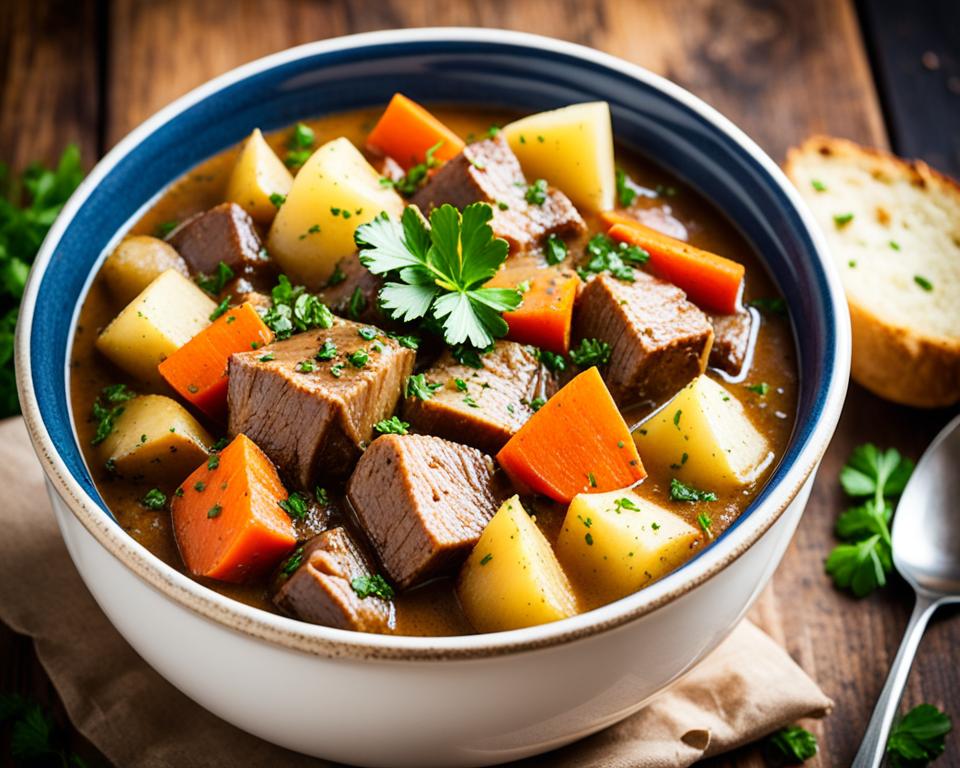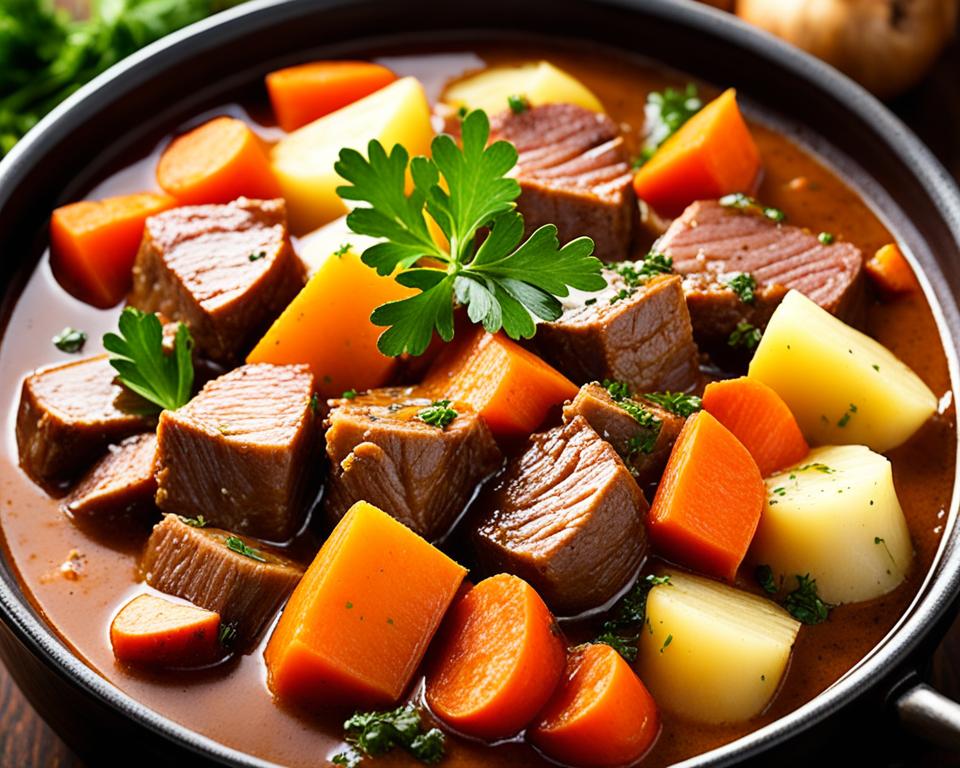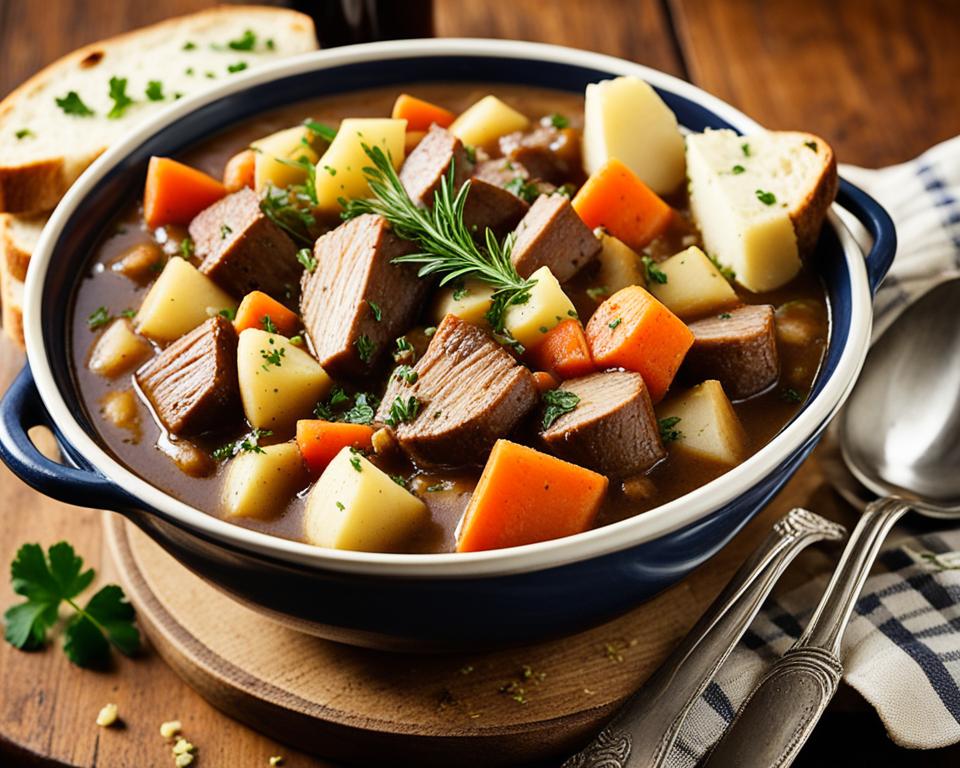
Introduction to Irish Stew
Welcome to our guide on how to make a traditional Irish stew, with authentic tips sourced straight from the BBC. This hearty dish is a staple of Irish cuisine, known for its rich flavors and comforting warmth. Whether you’re looking to recreate a taste of Ireland in your own kitchen or simply want to try something new, this recipe is sure to impress. Let’s dive in and discover the secrets behind a delicious bowl of Irish stew.
Read interesting things at : luoghievisioni
Key Takeaways
- Learn how to make a traditional Irish stew with tips from the BBC.
- Discover the rich history and cultural significance of Irish stew.
- Understand the essential ingredients that make up this iconic dish.
- Master the techniques for preparing and cooking your stew for optimal flavor.
- Explore variations and creative ideas for leftovers and serving suggestions.
The History of Irish Stew
Irish stew, a classic dish in traditional Irish cuisine, has a rich history that dates back centuries. This beloved culinary creation has been a staple in Irish households and has become synonymous with comfort and warmth.
The origins of Irish stew can be traced back to the 16th century, during a time when lamb was the primary meat consumed in Ireland. The dish was born out of necessity, as it was a simple and economical way to feed families using readily available ingredients.
Initially, Irish stew consisted of only a few key components: lamb, potatoes, onions, and water. It was a one-pot dish that was cooked slowly over an open fire, allowing the flavors to meld together and create a hearty and satisfying meal.
“Irish stew is a testament to the resourcefulness and ingenuity of the Irish people, who transformed humble ingredients into a dish that has stood the test of time.”
Over the years, different variations of Irish stew emerged, with some regions adding carrots, leeks, and barley to enhance the flavors. Each household had its own unique twist, resulting in countless interpretations of this traditional dish.
The cultural significance of Irish stew cannot be understated. It is intrinsically tied to the Irish identity and its strong agricultural heritage. The dish symbolizes resilience, simplicity, and the importance of coming together to share a meal.
The Evolution of Irish Stew
As Irish stew gained popularity, it also made its way beyond the borders of Ireland. Irish immigrants carried the recipe with them to different parts of the world, where it underwent further adaptations.
In America, for example, Irish immigrants used the ingredients available to them, such as beef, instead of lamb. This variation became known as “Irish American stew” or “Guinness beef stew,” highlighting the regional influences and adjustments made to suit local tastes.
Today, Irish stew retains its status as a beloved comfort food, cherished by people of Irish descent and culinary enthusiasts alike. Its enduring popularity is a testament to its simplicity, heartiness, and the deep-rooted connection it holds to Irish culture.
Join us in the next section as we explore the essential ingredients that make up an authentic Irish stew, guiding you towards creating a truly satisfying and flavorful dish.
Essential Ingredients for Irish Stew
When it comes to creating an authentic Irish stew, the key ingredients are what give this classic dish its unique and comforting flavors. By combining tender chunks of lamb with hearty root vegetables and aromatic herbs, you can create a culinary masterpiece that will warm your soul. Let’s take a closer look at the essential components that make up this beloved Irish dish.
1. Lamb: The star of the show, lamb is the primary protein in Irish stew. Opt for boneless lamb shoulder or leg meat, as they are perfect for slow cooking and will result in tender and flavorful chunks of meat.
2. Onions: Onions are a crucial element in Irish stew, providing a sweet and savory base for the dish. Their caramelized flavors add depth and richness to the overall taste.
3. Potatoes: Potatoes are a staple ingredient in Irish cuisine, and they play a significant role in Irish stew. They act as a thickening agent, creating a hearty and satisfying texture.
4. Carrots: Carrots add a touch of sweetness and vibrant color to the stew. They also contribute to the overall texture and provide a robust nutritional profile.
5. Parsnips: Adding parsnips to your Irish stew provides a subtle, earthy flavor that pairs well with the other ingredients. They add complexity and depth to the dish.
6. Fresh Herbs: Aromatic herbs like thyme and rosemary bring an enticing fragrance to the stew. They infuse each spoonful with a burst of flavor.
7. Bay Leaves: Bay leaves add a subtle and slightly sweet aroma to the stew. They are often used to enhance the overall taste and act as a natural flavor enhancer.
8. Beef or Vegetable Broth: Broth is essential for cooking the stew and creating a rich, flavorful base. Use beef broth for a heartier taste or vegetable broth for a lighter alternative.
9. Salt and Pepper: These essential seasonings elevate the flavors of the stew, ensuring a perfectly balanced taste.
10. Water: Water is added to the stew to ensure the ingredients are fully covered during the cooking process. It helps to maintain the consistency and ensures that all flavors meld together harmoniously.
To create your mouthwatering Irish stew, combine these essential ingredients in a large pot or slow cooker and simmer gently until the meat is tender and the flavors have melded together. Serve piping hot with freshly baked soda bread or crusty rolls for an authentic Irish dining experience.
“Irish stew is a timeless dish that encompasses the warmth and flavors of traditional Irish cuisine. The combination of tender lamb, root vegetables, and aromatic herbs creates a comforting and satisfying meal that’s perfect for any occasion.”
Choosing the Right Lamb for Your Stew
When it comes to making a delicious and flavorful Irish stew, selecting the right cut of lamb is crucial. The meat will not only contribute to the overall taste but also determine the tenderness of your stew. Here are some tips on how to choose the best cuts of lamb for your Irish stew.
1. Shoulder
The shoulder is one of the most popular cuts of lamb for stew. It is well-marbled with fat, which makes it flavorful and tender when slow-cooked. The shoulder can be left on the bone for added flavor or boned and diced for convenience.
2. Neck
The neck of the lamb is a lesser-known cut but is perfect for adding richness and depth to your stew. It contains a lot of connective tissue, which breaks down during the cooking process, resulting in a melt-in-your-mouth texture.
3. Shank
The lamb shank is another excellent choice for stew. It is a flavorful and well-exercised muscle, perfect for slow cooking. The meat becomes tender and falls off the bone, infusing the stew with incredible flavors.
4. Leg
The leg of lamb is a leaner cut that can still be used in stew. It is important to note that the leg requires longer cooking times to achieve optimal tenderness. Consider using the leg when you prefer a leaner stew or when other cuts are not available.
5. Try Different Cuts
Don’t be afraid to experiment with different cuts of lamb to find your favorite. Each cut has its own unique flavor profile and texture, which can elevate your stew in different ways. Visit your local butcher or meat counter, and they can recommend cuts that are best suited for stewing.
Pro Tip:
For the most flavorful stew, select cuts of lamb that are well-marbled with fat. The fat will render down during cooking, giving your stew a rich and satisfying taste. It’s also worth noting that bone-in cuts can add additional flavor to your stew.
Remember, the quality of your lamb will greatly impact the taste of your Irish stew. Take the time to select the best cuts of lamb that are suited for slow cooking and result in tender, succulent meat. By choosing the right lamb, you’ll be on your way to creating a truly memorable and delicious Irish stew.
Preparing Your Meat and Vegetables
When it comes to making the perfect Irish stew, proper preparation of the meat and vegetables is key. By following these expert tips, you can ensure that your stew is bursting with flavor and has the ideal texture.
Preparing Lamb for Irish Stew
Start by choosing high-quality lamb for your stew. Look for cuts that are well-marbled and have a good amount of fat, as this will contribute to the richness of the dish. Trim any excess fat and cut the lamb into bite-sized pieces, ensuring that they are all relatively uniform in size.
Expert Tip: For added tenderness and flavor, consider marinating the lamb in a mixture of olive oil, garlic, rosemary, and thyme for a few hours or overnight before cooking.
Before adding the lamb to the stew, it can be browned in a hot skillet to develop a rich caramelized flavor. This step is optional but highly recommended for an extra depth of taste.
Chopping Vegetables for Stew
When it comes to chopping the vegetables for your Irish stew, consistency is key. Aim to cut them into similar-sized pieces to ensure even cooking. Traditional vegetables used in Irish stew include potatoes, onions, carrots, and celery.
When peeling and cutting the potatoes, it’s best to leave the skins on for added texture and nutrients. For the other vegetables, remove any tough outer layers and chop them into bite-sized chunks.
| Vegetable | Cutting Method |
|---|---|
| Potatoes | Leave skin on, chop into bite-sized chunks |
| Onions | Peel, quarter, and slice into thin wedges |
| Carrots | Peel, cut into thick slices or chunks |
| Celery | Trim ends, slice into thick pieces |
By preparing your meat and vegetables with care and attention to detail, you can elevate your Irish stew to new heights of deliciousness. The proper techniques ensure that each bite is packed with flavor and tender goodness.
Cooking Techniques for Irish Stew
When it comes to cooking Irish stew, there are various techniques that can be employed to achieve the delicious flavors and tender textures that make this dish so beloved. Whether you prefer a traditional approach or want to experiment with new methods, understanding the cooking techniques is essential.
Gentle Simmering
One of the most common and traditional cooking methods for Irish stew is gentle simmering. This slow and steady approach allows the flavors to meld together while ensuring the meat becomes tender and succulent. To achieve this, start by searing the meat in a pot until browned, then add the vegetables and broth. Bring the mixture to a gentle simmer and let it cook for hours, allowing the flavors to intensify.
Oven Braising
Another popular technique for Irish stew is oven braising. This method involves searing the meat, adding vegetables and broth to a covered casserole dish, and then transferring it to a preheated oven. The low and slow heat of the oven allows the stew to cook evenly and develop rich flavors. Oven braising is a great option if you want to free up stovetop space or achieve a more hands-off cooking experience.
Pressure Cooking
For those who want to enjoy a hearty Irish stew in less time, pressure cooking can be a game-changer. Using a pressure cooker, you can achieve tender meat and perfectly cooked vegetables in a fraction of the time compared to traditional methods. The high pressure and steam in the cooker expedite the cooking process while still retaining the flavors and textures that make Irish stew so delicious.
Slow Cooker Convenience
If you’re looking for a hassle-free cooking experience, using a slow cooker is a great option. This method allows you to simply add all the ingredients to the slow cooker, set it to a low heat setting, and let it cook for several hours. The slow and gentle heat of the slow cooker ensures that the flavors meld together and the meat becomes tender. Plus, you can set it in the morning and come home to a comforting bowl of Irish stew in the evening.
Experimenting with different cooking techniques can add variety and excitement to your Irish stew cooking repertoire. Whether you choose to simmer, braise, pressure cook, or use a slow cooker, each method has its own benefits and can result in a mouthwatering, authentic Irish stew.
| Cooking Technique | Description |
|---|---|
| Gentle Simmering | A traditional method that involves simmering the stew on the stovetop for hours, allowing the flavors to meld together and the meat to become tender. |
| Oven Braising | The stew is seared and then cooked in a covered casserole dish in the oven, resulting in evenly cooked ingredients and rich flavors. |
| Pressure Cooking | Using a pressure cooker, the stew can be cooked in a fraction of the time, thanks to the high pressure and steam that expedite the cooking process. |
| Slow Cooker Convenience | A hassle-free option where all the ingredients are added to a slow cooker and left to cook for several hours, resulting in a comforting and flavorful Irish stew. |
Secret Ingredients and Flavor Enhancements
When it comes to making a truly exceptional Irish stew, knowing the secret ingredients and flavor enhancements can elevate your dish to new heights. These additions will add depth, complexity, and unique flavors that will make your stew stand out from the rest.
1. Herbs and Spices
Herbs and spices play a crucial role in enhancing the flavors of Irish stew. Traditional favorites include thyme, rosemary, and bay leaves, which infuse the stew with aromatic notes. For a bolder twist, experiment with spices like paprika, cumin, or even a pinch of cinnamon. The right combination of herbs and spices can take your stew from ordinary to extraordinary.
2. Guinness Stout
One of the most popular secret ingredients in Irish stew is Guinness Stout. This iconic Irish beer adds a rich, malty flavor and a velvety texture to the dish. As the stew slowly simmers, the Guinness Stout infuses its distinct taste, resulting in a hearty and robust flavor profile that will make your taste buds sing.
3. Worcestershire Sauce
A splash of Worcestershire sauce can work wonders in enhancing the umami flavors of your Irish stew. This savory and tangy sauce adds a depth of flavor that complements the meat and vegetables perfectly. Just a few drops can make a noticeable difference in the overall taste of your stew.
4. Lamb Stock
To intensify the lamb flavor in your stew, try using lamb stock instead of regular beef or vegetable stock. The lamb stock provides a rich and distinctive taste that harmonizes with the other ingredients, creating a more authentic and flavorful stew. You can either make your own lamb stock or find it in specialty stores.
5. Tomato Paste
For a touch of sweetness and acidity, add a spoonful of tomato paste to your Irish stew. The tomato paste will help balance the flavors and give the stew a vibrant red color. It also adds a subtle tang that complements the richness of the meat and vegetables.

| Secret Ingredients | Flavor Enhancements |
|---|---|
| Herbs and spices | Guinness Stout |
| Worcestershire sauce | Lamb stock |
| Tomato paste |
6. Other Enhancements
- Adding a splash of red wine can deepen the flavors and add complexity to your stew.
- For a smoky twist, incorporate a small amount of smoked paprika or smoked sea salt.
- For a touch of sweetness, a drizzle of honey or a handful of dried fruits like apricots or prunes can work wonders.
Remember, the key to using these secret ingredients and flavor enhancements is to find the right balance. Taste and adjust as you go, allowing the flavors to develop and meld together over time. With a bit of experimentation and these secret ingredients, you’ll create an Irish stew that will have everyone asking for seconds.
Serving Suggestions for Irish Stew
Once you’ve perfected your authentic Irish stew, it’s time to think about the best ways to serve it. Whether you prefer to enjoy the stew on its own or pair it with delicious side dishes, we have some serving suggestions that will enhance the flavors and textures of this hearty dish.
1. Standalone Meal
Irish stew is a satisfying and flavorful dish that can be enjoyed as a standalone meal. Serve a generous portion of the stew in a deep bowl or plate. Don’t forget to include plenty of the succulent lamb and vegetables in each serving. Garnish with fresh herbs, such as parsley or thyme, to add a pop of color and an extra layer of flavor.
2. Irish Soda Bread
Pair your Irish stew with a slice of warm Irish soda bread. The slightly sweet and dense bread is the perfect accompaniment to the rich and savory flavors of the stew. Spread some butter on the bread for an indulgent treat.
3. Colcannon
Colcannon, a traditional Irish side dish, is a delicious combination of mashed potatoes and sautéed greens, such as kale or cabbage. The creamy and comforting colcannon complements the stew beautifully and adds an extra element of heartiness to the meal.
4. Crusty Bread
If you prefer a simpler side dish, a crusty bread roll or baguette is a great option. The bread can be used to soak up the flavorful broth in the stew, adding an additional layer of texture and taste.
5. Roasted Vegetables
Roasted root vegetables, such as carrots, parsnips, and turnips, make a fantastic side dish for Irish stew. The caramelized flavors of the roasted vegetables provide a delicious contrast to the tender meat and savory broth. Season the vegetables with salt, pepper, and a sprinkle of dried herbs for extra flavor.
No matter how you choose to serve your Irish stew, be sure to take the time to enjoy each bite and savor the comforting flavors of this classic dish.
Leftover Ideas for Irish Stew
Don’t let any leftover Irish stew go to waste. There are plenty of creative ways to repurpose your stew into new, delicious dishes that will leave your taste buds wanting more. Whether you have a little or a lot of leftover Irish stew, here are some mouthwatering recipes and ideas to inspire you.
1. Irish Stew Shepherd’s Pie
If you have a generous amount of leftover Irish stew, why not turn it into a comforting Shepherd’s Pie? Simply layer the stew in a baking dish and top it with a layer of fluffy mashed potatoes. Bake until the potatoes are golden and serve with a side of green peas for a complete and satisfying meal.
2. Irish Stew Empanadas
Transform your Irish stew into handheld treats by filling empanada dough with the leftover stew. These savory turnovers make the perfect appetizer or snack. Serve with a dipping sauce of your choice, and watch them disappear in no time.
3. Irish Stew Hash
Add a creative twist to your breakfast or brunch with an Irish Stew Hash. Sauté some diced potatoes and onions in a skillet, then add your leftover stew, breaking it up into smaller pieces. Cook until everything is heated through and serve with a fried or poached egg on top for a hearty and satisfying meal.
4. Irish Stew Soup
Turn your leftover Irish stew into a comforting soup by adding some additional broth or stock. Simmer the stew with a splash of water or stock until it reaches your desired consistency. Serve with a warm slice of crusty bread for a cozy and delicious meal.
5. Irish Stew Tacos
Give your tacos an Irish twist by filling warmed tortillas with your leftover stew. Add some shredded cheese, chopped fresh herbs, and a squeeze of lime juice for extra flavor. These unique tacos are sure to impress your family and friends at your next taco night.
| Leftover Stew Recipe | Key Ingredients |
|---|---|
| Irish Stew Shepherd’s Pie | Leftover Irish stew, mashed potatoes |
| Irish Stew Empanadas | Leftover Irish stew, empanada dough |
| Irish Stew Hash | Leftover Irish stew, diced potatoes, onions |
| Irish Stew Soup | Leftover Irish stew, broth or stock |
| Irish Stew Tacos | Leftover Irish stew, tortillas, shredded cheese, fresh herbs, lime juice |
These are just a few ideas to get you started with repurposing your leftover Irish stew. Don’t be afraid to get creative and experiment with new flavors and combinations. With a little imagination, you can turn your leftovers into a whole new culinary experience.
Variations on Irish Stew
While traditional Irish stew is undeniably delicious, there are many exciting variations that allow you to put a unique twist on this classic recipe. From vegetarian alternatives to seafood-inspired creations, there’s a variation out there to suit every palate. Let’s explore some of these mouthwatering alternatives to the traditional dish:
1. Guinness Beef Stew
If you’re a fan of rich flavors, Guinness beef stew is a must-try. This hearty variation swaps lamb for beef and incorporates the distinct taste of Guinness stout. The dark beer adds a depth of flavor and richness that elevates the stew to new heights. Serve it with crusty bread for the ultimate comfort food experience.
2. Root Vegetable Stew
For a vegetarian twist on Irish stew, consider a root vegetable variation. This hearty and nutritious stew substitutes the meat with a medley of colorful root vegetables such as carrots, parsnips, and potatoes. The vegetables are slow-cooked in a flavorful broth, resulting in a satisfying and nutritious meal that even meat-lovers will enjoy.
3. Seafood Chowder Stew
If you’re a seafood enthusiast, a seafood chowder stew is a fantastic choice. This variation combines the creamy richness of a chowder with the comforting elements of Irish stew. Packed with a variety of fresh seafood such as mussels, shrimp, and cod, this stew is a delightful way to enjoy the flavors of the sea in a comforting and hearty dish.
“Variations on Irish stew allow you to experiment with different ingredients and flavors, expanding your culinary repertoire while still enjoying the comforting essence of the original dish.” – Chef Rachel O’Sullivan
4. Lamb and Guinness Pie
If you’re looking for a unique and indulgent twist on Irish stew, try a lamb and Guinness pie. This variation takes all the delicious components of Irish stew, including tender lamb and savory vegetables, and encases them in a flaky pastry crust. The result is a delectable individual pie that’s perfect for a hearty dinner or a special occasion.
5. Colcannon Stew
Colcannon stew is a wonderful combination of Irish stew and colcannon, a traditional Irish dish made from mashed potatoes and cabbage. This variation incorporates the creamy mashed potatoes and tender cabbage into a flavorful lamb stew. The result is a comforting and satisfying meal that brings together the best of both dishes.
| Irish Stew Variation | Main Ingredients |
|---|---|
| Guinness Beef Stew | Beef, Guinness stout, root vegetables |
| Root Vegetable Stew | Assorted root vegetables, vegetable broth |
| Seafood Chowder Stew | Assorted seafood, cream, potatoes, vegetables |
| Lamb and Guinness Pie | Lamb, Guinness stout, vegetables, pastry crust |
| Colcannon Stew | Lamb, potatoes, cabbage, vegetables |
Exploring these variations on Irish stew allows you to expand your culinary repertoire and enjoy new and exciting flavors while still savoring the comforting essence of the original dish. Whether you’re a vegetarian, a seafood lover, or a fan of rich and indulgent flavors, there’s a variation of Irish stew out there that’s sure to please your taste buds.

Storing and Freezing Irish Stew
Properly storing and freezing your Irish stew is essential to preserving its flavors and extending its shelf life. Whether you have leftover stew or want to prepare a batch in advance, these tips will help you enjoy this hearty dish for days to come.
Storing Irish Stew
When storing Irish stew, it’s important to keep it in an airtight container to prevent any flavor absorption or contamination. Follow these steps:
- Allow the stew to cool completely before storing it.
- Transfer the stew to a clean, airtight container. Glass or plastic containers with tight-fitting lids work best.
- Label the container with the date and contents to help you keep track of freshness.
- Store the stew in the refrigerator, where it can stay fresh for up to 3-4 days.
Freezing Leftover Stew
Freezing leftover Irish stew is a great way to save it for later use. Here’s how to freeze it properly:
- Cool the stew completely before freezing it.
- Divide the stew into individual servings or family-sized portions, depending on your needs.
- Place each portion of stew in airtight freezer-safe containers or freezer bags.
- Label each container or bag with the date and contents for easy identification.
- Remove any excess air from the bags before sealing them.
- Place the containers or bags in the freezer and ensure they are stored flat to save space.
Tip: To prevent freezer burn and extend the quality of your frozen Irish stew, consider using a vacuum sealer for airtight packaging.
Properly frozen Irish stew can last in the freezer for up to 3 months, although it’s best to consume it within 1-2 months for optimal taste and texture.
When you’re ready to enjoy your frozen stew, thaw it in the refrigerator overnight. Once thawed, reheat it on the stovetop or in the microwave until piping hot. Remember to discard any leftover stew that has been left at room temperature for more than 2 hours to ensure food safety.
| Storage Method | Shelf Life |
|---|---|
| Refrigerator | 3-4 days |
| Freezer | Up to 3 months |
Expert Tips for Perfect Irish Stew
Looking to elevate your Irish stew to perfection? Look no further. Our experts have gathered their top tips and cooking advice to help you create a mouthwatering dish that will impress even the most discerning stew connoisseurs.
1. Choose the Best Quality Ingredients
When it comes to making Irish stew, quality ingredients are key. Opt for fresh, locally sourced lamb and organic vegetables whenever possible. This will ensure the flavors shine through and provide a truly authentic taste experience.
2. Slow and Low is the Way to Go
To achieve tender and succulent meat, it’s important to cook your stew at a low and gentle heat. This slow cooking method allows the flavors to meld together beautifully while keeping the lamb juicy and flavorful. Patience is a virtue when it comes to mastering the art of Irish stew.
3. Seasoning is Essential
Seasoning plays a crucial role in enhancing the flavors of your stew. Generously season your meat and vegetables with salt and pepper, and don’t be afraid to add herbs and spices such as thyme, rosemary, and bay leaves for an extra layer of depth and aroma.
4. Achieving the Perfect Consistency
The ideal Irish stew should have a thick and hearty consistency. To achieve this, allow the stew to simmer uncovered during the final stages of cooking. This will help reduce the liquid and concentrate the flavors, resulting in a rich and velvety texture.
5. Let It Rest and Reheat
Like a fine wine, Irish stew benefits from a little resting time. Once cooked, allow your stew to cool slightly before serving. This will allow the flavors to further develop and intensify. Leftover stew can be reheated on the stovetop or in the oven for an equally delicious meal the next day.
“The secret to a perfect Irish stew lies in the slow cooking process and the use of high-quality ingredients. Take your time, be patient, and the result will be a dish that warms both the body and the soul.” – Chef Michael O’Sullivan
By following these expert tips and cooking advice, you’ll be well on your way to creating a truly perfect Irish stew. Don’t be afraid to experiment and make the recipe your own, adding your favorite vegetables or spices to customize the flavors to your liking. With a little practice and a whole lot of love, your Irish stew will become a household favorite in no time.
| Tips for Making Irish Stew | Cooking Advice for Stew |
|---|---|
| Choose the Best Quality Ingredients | Seasoning is Essential |
| Slow and Low is the Way to Go | Achieving the Perfect Consistency |
| Let It Rest and Reheat |
Reader Feedback and Testimonials
Don’t just take our word for it – hear what others have to say about our authentic Irish stew recipe! Our readers have tried and tested this recipe, and the results have been nothing short of amazing. Read on to discover why our easy Irish stew recipe from BBC Food is considered one of the best in the world.
“I’ve always wanted to try my hand at making Irish stew, and this recipe made it a breeze. The flavors were spot on, and the meat was incredibly tender. It’s now become a go-to dish in our household!” – Sarah
Many readers have shared their success stories and how our easy Irish stew recipe has become a staple in their homes. The combination of rich flavors, hearty ingredients, and simple preparation has won over the hearts and taste buds of countless individuals.
“Being a busy mom, I needed a recipe that is both delicious and easy to make. This Irish stew ticks all the boxes. I can’t thank BBC Food enough for sharing this gem!” – Jennifer
Our recipe has also received rave reviews for its accessibility and straightforward instructions. Even those who have never attempted to cook Irish stew before have found success with our recipe, making it the perfect introduction to this iconic dish.
If you’re in search of the best Irish stew recipe, look no further. Our easy-to-follow instructions, combined with the unbeatable flavors of this classic dish, make it a winner in every kitchen.
So why wait? Try our BBC Food Irish stew recipe today and join the chorus of satisfied home cooks who have discovered the secret to a comforting and delicious meal.
Conclusion
After exploring the rich history, essential ingredients, cooking techniques, and variations of Irish stew, it is clear that this beloved dish continues to capture the hearts and palates of people around the world. The tradition and authenticity behind the recipe, combined with the hearty flavors and comforting textures, make Irish stew a timeless classic.
With the guidance of BBC’s authentic tips and expert advice, you can now confidently finalize your own pot of delicious Irish stew. From selecting the best cuts of lamb to incorporating secret ingredients and flavor enhancements, every step in the process has been carefully considered to ensure a truly memorable dining experience.
Whether you enjoy it on a chilly winter evening, as a comforting family meal, or as a celebration of Irish culture, Irish stew is a dish that brings people together. So, why not gather your loved ones, embrace the warmth of a simmering pot, and savor the pure delight of this iconic Irish culinary masterpiece? Let the tradition and flavors of authentic Irish stew fill your home and hearts with the goodness it has been delivering for generations.






